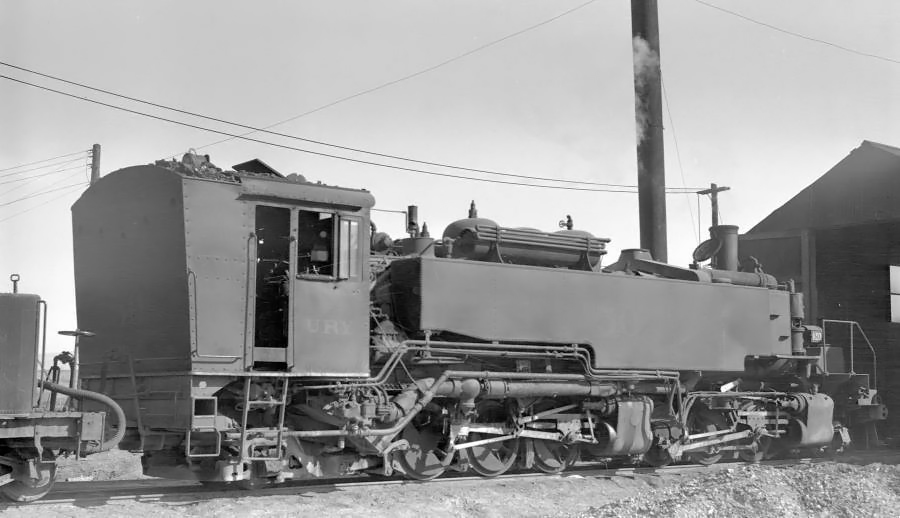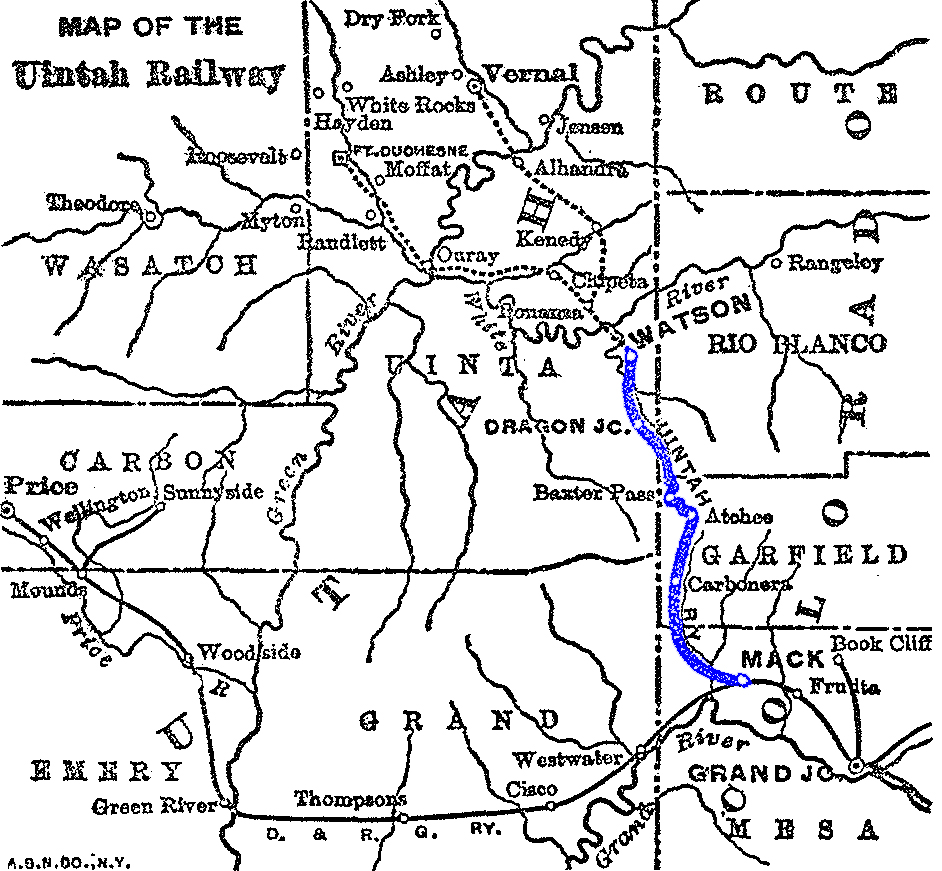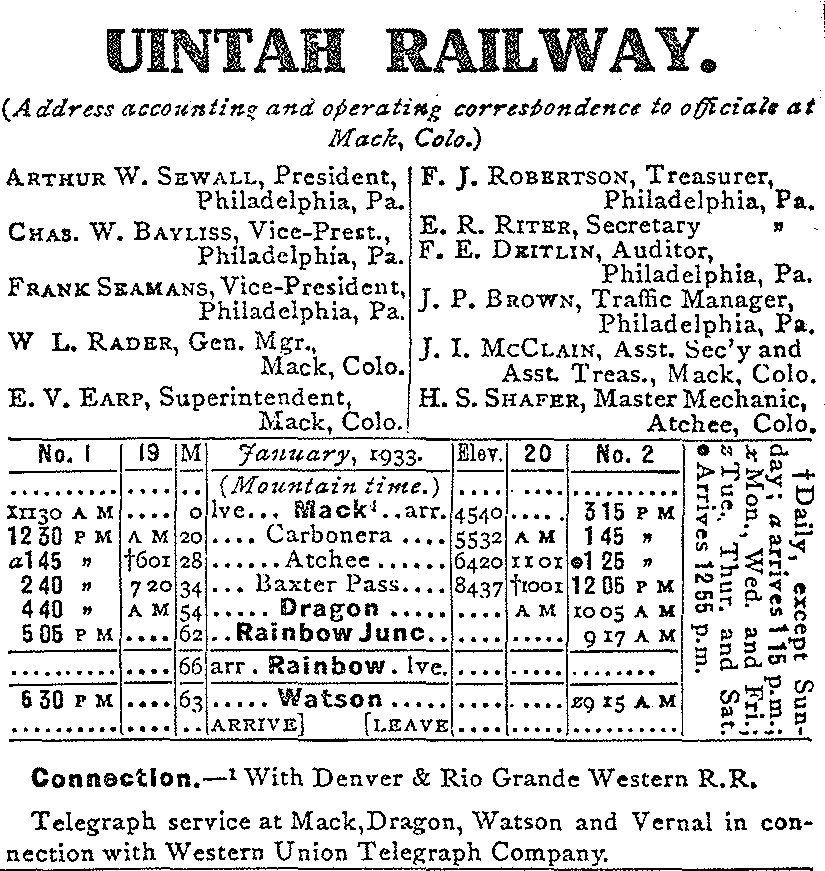Uintah Railway: Map, Roster, Timetables, History
Last revised: September 10, 2024
By: Adam Burns
Among 3-foot, narrow-gauge systems the Uintah Railway was built very late, formed in 1903 by the Barber Asphalt Paving Company - a division of the General Asphalt Company - as a wholly owned subsidiary for the purpose of moving Gilsonite.
The name 'Uintah' was chosen to signify the unique geographical area it would serve - the vibrant, resource-rich region of Uintah Basin in Utah and a part of Colorado.
Gilsonite was a type of asphaltum named after Samuel Henry Gilson who first used the material in 1886 as a varnish and electrical insulation.
The Uintah Railway was built solely to handle this product, opening its initial main line between western Colorado and northeastern Utah in 1904. However, the railroad was also formed as a common-carrier and provided passenger service within this isolated area of the U.S.
The railroad became famous among railfans, and somewhat throughout the industry, for its extremely steep grades and very sharp curves. It operated two of the most unique locomotives ever placed into service, 2-6-6-2T Mallets that spent more than a decade in operation before the railroad closed in 1939.
Photos
 One of the Uintah Railway's unique 2-6-6-2T Mallet Moguls, #50, built by Baldwin in 1926. It was one of two the railroad owned.
One of the Uintah Railway's unique 2-6-6-2T Mallet Moguls, #50, built by Baldwin in 1926. It was one of two the railroad owned.History
In its decades of operation, the Uintah Railway served multiple towns in both Utah and Colorado. Interestingly, the line originated at the town of Mack, located in Colorado, and spanned the distance to many communities including Watson, Rainbow, Atchee, Dragon, and ended at the town of Watson in Utah.
Other towns indirectly served by the goods and passengers transported along the line included Salt Lake City in Utah and Denver in Colorado.
In the late 19th century Gilsonite, a naturally occurring, solid, black, lightweight mineral pitch that originates from the solidification of petroleum, became popular in everyday products such as paints, varnishes, insulation, flooring, roofing, and other applications.
Today, the commodity is still used in various products including the manufacturing of automotive polish, printer's ink, and even explosive detonators. At the time, the Uintah Basin was the only place in the world where Gilsonite could be mined.
In the early 20th century the area was so rural the only means of economical extraction was via railroad, although building such a transportation artery would require extremely steep grades and sharp curves.
To keep costs down management of the General Asphalt Company decided to build the line to 3-foot, narrow-gauge standards. The Uintah Railway Company's initial route ran 53 miles from a connection with the Rio Grande Western (later Denver & Rio Grande Western) at Mack, Colorado to Dragon, Utah, location of the Dragon Mine.
Building north from the RGW, engineers utilized that railroad's former narrow-gauge road bed (abandoned in 1890 when the railroad was updated to standard gauge) for about 3 miles. It then climbed the West Salt Wash for 28 miles before arriving at Atchee where the route was then forced to negotiate Baxter Pass.
As George Hilton notes in his book, "American Narrow Gauge Railroads," the Uintah Railway actually more closely resembled logging railroads of that era instead of typical narrow-gauge operations.
The grade to the summit of this pass topped out at a grueling 7.5% and featured curves exceeding 60° in some locations.
In fact, the curve at Moro Castle (Milepost 30) was an incredible 75°, easily making it the sharpest found on any common-carrier railroad in the United States. This curve was later amended to 66° but still held the title of most severe.
From Baxter Pass the line descended on 5% grade into McAndrews and then followed Evacuation Creek into Dragon.
The Uintah Railway's traffic was predominantly Gilsonite; it was transported in a somewhat unique fashion by railroad standards, burlap sacks weighing 150-200 pounds each.
Apart from Gilsonite, the railway also transported a range of other freight. This included regular goods such as food, mail, agricultural products, lumber, livestock, and wool which were vital for the towns it served.
Alongside the passenger service, this freight transportation helped bolster local economies and supported the communities along its route.
The passenger service on the Uintah Railway exemplified its function as a vital link in the regional transport network. Passenger service started just after the railway's establishment, and continued until 1938. It was much loved by local communities.
After a few years of operation, the railroad began an extension northward beyond Dragon in 1908. Initially, plans were to push rails as far as Vernal (via Bonanza), tunnel Baxter Pass, and update the property to standard gauge.
Ultimately, however, the extension only ran 9.6 miles down Evacuation Creek to Watson and the railroad remained a narrow-gauge operation.
From a location known as Rainbow Junction (about a mile south of Watson) a spur of 4 miles, featuring grades of 5.1%, was extended to Rainbow where the largest deposit of Gilsonite in the region was discovered.
Operations
The railroad's steep grades required the use of geared steam locomotives; in 1910 it acquired five, 2-truck Shays and added a sixth in 1920. All were built by the Lima Locomotive Works. Another, #7, was built by the Atchee Shops in 1933 from the spare parts of #1, #3, and #4 and a new Lima boiler.
2-6-6-2T Mallets
The railroad also operated four standard, 2-8-0 rod engines built by Baldwin, as well as a pair of 0-6-2T tank engines used in passenger assignments, and a pair of standard rod 2-8-2s.
Its most famous engines were a pair of 2-6-6-2T Mallet Moguls acquired from Baldwin in 1926 (#50) and 1928 (#51). This unique, articulated locomotives were capable of operating the entire railroad, including the steep grades and sharp curves of Baxter Pass.
Given the challenging steep terrain along the route, the unique design of the engine allowed it to navigate the mountainous landscape with relative ease. Moreover, their substantial power and size made them a marvel to behold and an integral part of the railway's history.
The 2-6-6-Ts were the only two examples of their type ever built for an American railroad and were widely considered a phenomenal success.
System Map (1933)

Decline
Despite serving a valuable purpose and operating successfully for many years, the Uintah Railway began to decline around the mid-20th century.
This slide was primarily due to the advent of new modes of transportation, most notably the trucking industry, which was on the rise during this period. Additionally, the Great Depression during the 1930s devastated many a railway company, including the Uintah Railway.
The railroad had built a toll road to Dragon, known as the Uintah Toll Road Company, which opened in 1906. It also reached Vernal, Fort Duchesne, and the former Uintah Indian Reservation.
By 1921, the company ended regularly scheduled automobile service between Watson and Vernal and cutback passenger rail service to three-times a week. In 1929 this was reduced to merely a mixed train but ran daily except Sunday.
The General Asphalt Company (which became the Barber Company, Inc. in 1936), despite having still considered extending the railroad to Vernal as late as 1917, had lost interest in the operation by the mid-1930s as an increasing number of roads were built into the area.
The toll road was turned over to the county in 1936 and the railroad applied for abandonment in August, 1938 (by December of that year passenger service was reduced to one mixed train weekly on Tuesdays).
The Interstate Commerce Commission approved the application in April, 1939 and the final train ran on May 16, 1939. By 1940 the entire railroad had been dismantled.
The Uintah Railway's fascinating Mallet Moguls, impressively built track, and other steam engines are still fondly remembered by railroad enthusiasts.
Timetables (1933)

Final Years
The Uintah Railway was an instrumental part of the growth and development of the region it served for more than three decades. Despite the inevitable decline it faced, the railway continues to hold a place of prominence in the history of railroad development in the United States.
It remains a significant symbol of engineering excellence, innovation, and industry. The history and legacy of the Uintah Railway are still preserved through the stories of the people it served, the towns it connected, and the unique natural resource—Gilsonite—it transported.
Sources
- Griffin, James R. Rio Grande Railroad. St. Paul: Voyageur Press, 2003.
- Hilton, George. American Narrow Gauge Railroads. Stanford: Stanford University Press, 1990.
Recent Articles
-
Florida - Wine Tasting - Train Rides
Dec 22, 25 11:47 AM
Wine by train not only showcases the beauty of Florida's lesser-known regions but also celebrate the growing importance of local wineries and vineyards. -
Iowa Thomas The Train Rides
Dec 22, 25 10:50 AM
This article explores the magical journey of spending a day with Thomas and what families can expect from this unforgettable experience in Iowa. -
North Carolina Thomas The Train Rides
Dec 22, 25 10:45 AM
North Carolina is one of the few states home to two different Thomas the Tank Engine events. Learn more about them here!


